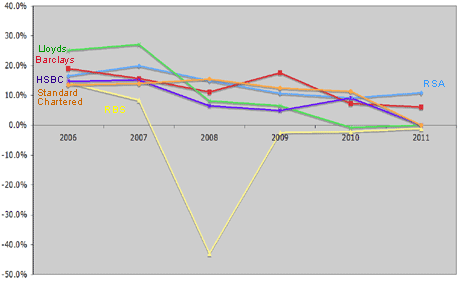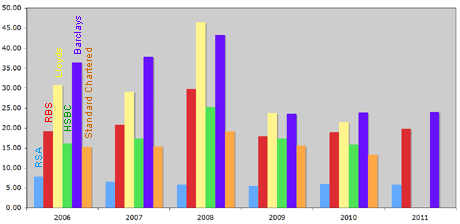Forget punting on banks – buy this high-yielding insurer instead
Bank stocks are still toxic, and much of the financial sector remains out of favour. But this insurer offers solid returns with relatively low risk, says Phil Oakley.
Finding a decent source of income is getting harder. Interest rates haven't improved, but with lots of investors chasing the defensive stocks' story, dividend yields are no longer as tempting as they were.
That makes insurer RSA- still yielding more than 8% - look pretty tempting. So should you buy it?
RSA delivers solid returns with low risk
Certainly, RSA's results for 2011- out this morning - look good. It has continued to perform well by sticking to a simple business model- a disciplined approach to insurance and a low risk investment portfolio.
MoneyWeek
Subscribe to MoneyWeek today and get your first six magazine issues absolutely FREE

Sign up to Money Morning
Don't miss the latest investment and personal finances news, market analysis, plus money-saving tips with our free twice-daily newsletter
Don't miss the latest investment and personal finances news, market analysis, plus money-saving tips with our free twice-daily newsletter
Underwriting profits grew by 58%. Investment returnsgrew by 19%, as RSA locked in some profits on selling shares. Meanwhile, the dividend was raised by 4% to 9.16p per share.
So far so good, but what about the future?
We like RSA's low-risk approach to investment. A full 89% of its portfolio is invested in high -quality fixed-income and cash assets and it has minimal exposure to weak eurozone government debt. This makes RSA a relatively low-risk investment.
But the trade-off is that it now faces a problem. Like a pensioner searching for a good annuity rate, RSA has fallen victim to the low interest rate world. As many of the existing bonds in its portfolio mature, they are being replaced with ones offering much lower rates. This means lower investment income.
In 2012, RSA expects investment income of around £500m compared with £579m in 2011. That's quite a big drop. So even though underwriting profits should grow, and the current dividend payout looks safe, growing the dividend will be a struggle.
Yet the shares are still attractive
Having said that, RSA looks a far better bet on a risk/return basis than investing in UK banks, for example.
Why? Because it earns better returns for shareholders, while taking a lot less risk.
Look at the chart below. In 2011, RSA had a return on equity (ROE)of 10.9%. Of the main UK-listed banks, only Asia-focused Standard Chartered - with an ROE of 11.4% - is performing better.
Barclays, in stark contrast had an ROE of 6.1% in 2011. In fact RSA, more often than not, has delivered better returns for its shareholders than Barclays during the last five years.
RSA v banks: return on equity

But that's not the most important fact. What's even better, is that RSA earns its returns with a lot less leverage (assets divided by capital) than the banks. This makes it a lot less risky as the chart below shows. RSA is shown in pale blue, while the other colours represent individual UK banks. As you can see, RSA is by far the least geared of them all.
Assets-to-capital ratio

The fact is, we're in a deleveraging world. That means that life is going to be tough for most financial stocks. High returns look like a thing of the past. And this is exactly why RSA's high yield backed by a lower-risk business model is attractive.
At 108p, RSA has a dividend yield of 8.5%. Even if this doesn't grow much, that's still pretty decent. Add in the fact that the net asset value (NAV) per share is 104p and RSA looks a conservative investment.
An alternative, lower-risk way to play RSA
Of course, high yields rarely come without risk. Even though RSA has twice the amount of capital that regulators require, many are worried that it may have to issue more shares to make it even less risky. This could mean future dividend cuts.
If this concerns you then there is still a good way to invest in RSA. The 7 3/8% cumulative irredeemable preference shares (LSE: RSAB) currently yield 6.8% at an offer price of 108p. As I've explained before, the dividend on these shares has to be paid before the ordinary shares. Based on 2011 profits, the preference dividends look very safe and are covered 47 times.
Disclosure: I own RSA preference shares.
Get the latest financial news, insights and expert analysis from our award-winning MoneyWeek team, to help you understand what really matters when it comes to your finances.
Phil spent 13 years as an investment analyst for both stockbroking and fund management companies.
After graduating with a MSc in International Banking, Economics & Finance from Liverpool Business School in 1996, Phil went to work for BWD Rensburg, a Liverpool based investment manager. In 2001, he joined ABN AMRO as a transport analyst. After a brief spell as a food retail analyst, he spent five years with ABN's very successful UK Smaller Companies team where he covered engineering, transport and support services stocks.
In 2007, Phil joined Halbis Capital Management as a European equities analyst. He began writing for MoneyWeek in 2010.
-
 Investors will reap long-term rewards from UK equities
Investors will reap long-term rewards from UK equitiesOpinion Nick Train, portfolio manager, Finsbury Growth & Income Trust, highlights three UK equities where he’d put his money
-
 The graphene revolution is progressing slowly but surely
The graphene revolution is progressing slowly but surelyEnthusiasts thought the discovery that graphene, a form of carbon, could be extracted from graphite would change the world. They might've been early, not wrong.